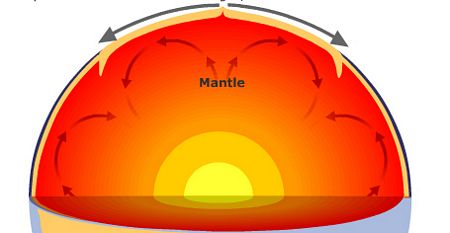Strange structure beneath the Earth's crust
Recently, scientists found that in the Earth's crust there is a layer of rock with high adhesion and very hard, this may be the cause of the heat in the Earth can not escape out.
Under the earth's crust exist strange stone layer
According to the latest scientific news in Live Science, the researchers found a cohesive layer of rock that exists deep within the Earth's surface . This rock may be responsible for the tectonic plates - part of the Earth's crust - that can stand when they slip on submerged areas.

Science discovered new ingredients in Earth's crust
The structure of the Earth includes : Core, mantle and crust. The Earth's surface (outer shell) is divided into tectonic plates about 95 to 105 km thick, they move very slowly on the Earth's surface for millions of years. Each tectonic plate consists of both the continental and ocean sections (except the tectonic plate of the Pacific region with only the Ocean part).
In these tectonic plates, ocean plate edges bend into a diving carpet, or "suppressing" under the continental plate, and sink into the earth's crust . According to Lowell Miyagi, a physicist at the University of Utah, Salt Lake City, the process takes place very slowly on average, it takes about 300 million years for tectonic plates to sink.

Detect strange cohesive rock layer under the Earth's crust
Many studies have shown that tectonic plates move slowly and can bind together in the upper part of the shell at a lower position with a depth of about 1500km. The typical area that can clearly see this movement is below the coast of Indonesia and South America Pacific. The discovery of a new layer in the Earth's crust could help researchers find layers of rock in the upper part of the Earth's crust that potentially mix diamonds three times heavier than other rock layers in place. lower position.
Scientists used X-rays to scan thousands of crystals of ferropericlase, the second-largest mineral in the lower Earth's envelope. Pressure reaches 96 GPa and extremely high temperatures in the Earth's worm compresses atoms and electrons so tightly that they interact in a completely different way. The researchers unexpectedly found that ferropericlase concentrations began to increase at a depth of 660 km with equivalent pressure, marking the boundary between the upper and lower mantle shells. Under the same pressure conditions at a depth of about 1500km, ferropericlase concentrations tripled.

Decode different magma eruptions by a strange component under the Earth's crust
In addition, when studying the properties of deep underground ferropericlase mixed with bridgmanite, the main mineral in the lower coating, the scientists discovered that this coating has a hardness and adhesion higher than 300 times. compared to the upper and lower overlay about 660 km away. At 1 Pa / s pressure conditions, adhesion is about 0.001.
This new finding raises doubts that the earth's heart is hotter than previously known information . According to Miyagi, this sticky stone can reduce the stone's ability to mix minerals under the earth's crust. Therefore, the heat in the Earth's heart is difficult to escape to the planet. Moreover, this also explains the difference between magma erupting on the surface of the earth through the craters on the seabed. In the future, researchers hope to explain why the mixture of ferropericlase and bridgmanite can adapt to extreme pressure and temperature in the ground.
- Mountain ranges floating on lava
- Detecting strange convex spiral structures on Mars
- First decoding the internal structure of the HIV virus
- Bread crust prevents cancer
- Decoding the mysterious geological structure in America
- Super UFO structure discovered in Australia sky
- Discovering the super giant structure that can
- Find the bizarre structure on Jupiter's Moon
- New discovery about the formation of Earth's crust
- Earth's crust melts easier than we thought
- The deeper you go into the Earth's core, the higher the temperature: Why is that?
- Earth's crust is unstable over time
 'Fine laughs' - Scary and painful torture in ancient times
'Fine laughs' - Scary and painful torture in ancient times The sequence of numbers 142857 of the Egyptian pyramids is known as the strangest number in the world - Why?
The sequence of numbers 142857 of the Egyptian pyramids is known as the strangest number in the world - Why? History of the iron
History of the iron What is alum?
What is alum? What would happen if you dug a hole through the Earth and jumped in?
What would happen if you dug a hole through the Earth and jumped in?  Chilling discovery of cosmic object that almost brought the Earth to 'apocalypse'
Chilling discovery of cosmic object that almost brought the Earth to 'apocalypse'  The Sun goes into hibernation, will the Earth usher in a new ice age?
The Sun goes into hibernation, will the Earth usher in a new ice age?  Discovery of space object powerful enough to tear apart the Earth
Discovery of space object powerful enough to tear apart the Earth  NASA to test 'pneumatic brakes' for Mars lander
NASA to test 'pneumatic brakes' for Mars lander  Breakthrough discovery of planet with more water than Earth
Breakthrough discovery of planet with more water than Earth 